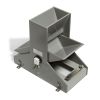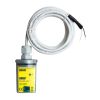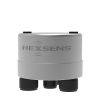KISTERS Dual Tipping Bucket Flow Gauges
Features
- Two distinct buckets provide best accuracy over a large range of flows
- Two buckets operate simultaneously up to 6L per minute
- Includes 24VDC dual reed switch
- Expedited repair and warranty service
- Lifetime technical support
- More
Overview
The KISTERS TBL-70 dual tipping bucket flow gauge is used for measuring water seepage coming out of a pipe or a drain. The unit is equipped with two distinct buckets to provide best accuracy over a large range of flows: a smaller bucket at the top of the gauge to measure at low flows and a larger one at the bottom to measure at high flows. Each bucket is connected to its own dual reed switch effectively enabling redundant data acquisition in two distinct data loggers, or providing data to two devices (e.g. a data logger and a counting display), etc.
Operation
The two buckets operate simultaneously up to 6L per minute. At low flows where the large bucket is not full to tip, more accurate results can be obtained from the small bucket’s reed switch output. At higher flows above 6L per minute, the smaller bucket at the top has to be removed by the user. Data is then generated solely by the larger bucket’s reed switch output.
| Material | PVC plastic and stainless steel | ||||||||||||||||||||||||
| Resolutions |
|
||||||||||||||||||||||||
| Accuracy |
0.5/1L bucket
70ml bucket
|
||||||||||||||||||||||||
| Signal Out |
|
||||||||||||||||||||||||
| Flow Rate | Maximum 25 L/minute | ||||||||||||||||||||||||
| Level | Bulls eye level adhered to stainless steel base | ||||||||||||||||||||||||
| Environmental Conditions |
|
||||||||||||||||||||||||
| Dimensions & Mass |
|
In The News
Save our Bogs! Culture, Conservation and Climate Action in Ireland’s Peatlands
Characterized by long-term accumulation under waterlogged conditions, peatlands exist on every continent and account for 3-4% of the global land surface . Small but mighty, these often overlooked wetland environments are estimated to hold as much as one-third of the world's organic carbon in their soil—twice the amount found in the entirety of the Earth's forest biomass. While healthy peatlands can trap and store carbon, regulate water, and provide important habitats for rare species, human alteration has disturbed peatland carbon and nitrogen cycles on a global scale. Approximately 12% of the world’s peatlands have been drained and degraded through conversion for agriculture, forestry, infrastructure development, and other uses.
Read MoreSargassum Surge: How Seaweed is Transforming our Oceans and Coastal Ecosystems
Until recently, Sargassum –a free-floating seaweed–was distributed throughout the Sargasso Sea , the north Caribbean Sea, and the Gulf of Mexico. But in the space of a decade, this seaweed has, as one scientist remarks , “Gone from a nonfactor to the source of a terrible crisis.” Driven by climate change, anomalous North Atlantic Oscillation in 2009-2010 and a glut of anthropogenic pollutants, sargassum has proliferated. Seasonally recurrent mats as deep as 7m now bloom in the “Great Atlantic Sargassum Belt” (GASB), which covers areas of the Atlantic from West Africa to the Caribbean Sea and Gulf of Mexico. Every year, millions of tons wash up along the shores of more than 30 countries . Dr.
Read MoreGreat Lakes Research Center: Designing Targeted Monitoring Solutions
According to the National Oceanic and Atmospheric Administration ( NOAA ), the Great Lakes have more miles of coastline than the contiguous Atlantic and Pacific coasts combined and contain 20 percent of the world's freshwater, making it a critical region to protect and conserve. Continuous monitoring and data-informed resource management are key components of managing waters in the region. Hayden Henderson, a research engineer with the Great Lakes Research Center (GLRC), designs and deploys monitoring platforms throughout the Great Lakes. With a background in environmental engineering, Henderson enjoyed the challenge of creating systems and making them work to obtain difficult, remote measurements.
Read More










